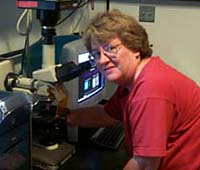
Research Associate Professor of Biochemistry and Molecular Biology, University of Massachusetts
Email: mcannon@biochem.umass.edu
M. Cannon Biochemistry & Molecular Biology Web Site
M. Cannon Lab Website
Ph.D.: National University of Ireland, Galway
Postdoctoral Training: University of Sussex, U.K.
Plant cell wall assembly and its influence on cell division.
A large family of developmentally regulated cell wall structural proteins, the extensins- a subgroup of hydroxyproline-rich glycoproteins, is the current focus of research in my lab. Our work is directed towards understanding the role of extensins in wall assembly and in particular how they contribute to the correct positioning of the cell plate during cytokinesis. The plant cell wall is an extracellular matrix with dynamic properties comprising three polymeric networks: cellulosic, pectic and structural glycoproteins. The properties of this self-assembling supermolecular structure arise from its correct assembly, a process about which we know almost nothing.
To place this research in context, it is part of a long-term and far-reaching goal to identify the critical players in plant cell division and growth. These processes are continuous throughout the life cycle of a plant; they are punctuated by cell differentiation at cytokinesis, the final stage of cell division. Differentiation usually begins when a cell divides to produce two cells, each different from the other in size, shape and/or contents. Appropriately differentiated cells, growing and working in concert, result in the plants architecture, size, shape, and ability to function. To build a plant many different molecular events must take place in the cell to ensure that the required molecules are synthesized, processed and delivered to construction sites where and when they are required. The plant cell wall is an exquisite example of the end result of such a complex series of regulated events. There are approximately 40 cell types in the model plant Arabidopsis, each with what appears to be a tailor-made wall in constant flux allowing the plant to develop and grow while protecting the cell, hence the plant, from disease and invasion. Our current research addresses the role of extensins in cell wall assembly, and how this influences plant growth and development.
Representative publications:
Saha P, Ray T, Tang Y, Dutta I, Evangelous NR, Kieliszewski MJ, Chen Y, Cannon MC. Self-rescue of an EXTENSIN mutant reveals alternative gene expression programs and candidate proteins for new cell wall assembly in Arabidopsis. Plant J. 2013 Jul;75(1):104-16. doi: 10.1111/tpj.12204. Epub 2013 May 16.
Lamport DTA, Kieliszewski MJ, Chen Y, & Cannon MC. Role of the Extensin Superfamily in Primary Cell Wall Architecture. 2011. Plant Physiology 156(1):11-19.
Kieliszewski MJ, Lamport DTA, Tan L, Cannon, MC. Hydroxyproline-rich Glycoproteins: Form and Function. 2011. In, P. Ulvskov (ed), Annual Plant Reviews. Plant Polysaccharides: Biosynthesis and Bioengineering. Wiley Blackwell, Oxford, Vol 41, pp 321-342.
Hall, Q. and Cannon, M.C. (2002). The cell wall hydroxyproline-rich glycoprotein RSH is essential for normal embryo development in Arabidopsis. Plant Cell 14:1161-1172.
McCool, G. J. and M. C. Cannon (2001). "PhaC and PhaR are required for polyhydroxyalkanoic acid synthase activity in Bacillus megaterium." J Bacteriol 183(14): 4235-43.
McCool, G.J. and Cannon, M.C. (1999) Polyhydroxyalkanoate inclusion body-associated proteins and coding region in Bacillus megaterium. J. Bacteriol. 181, 585-592.
Li, N. and Cannon, M.C. (1998) Gas vesicle genes identified in Bacillus megaterium and functional expression in Escherichia coli. J.Bacteriol. 180, 2450-2458.
McCool, G.J., Fernandez, T., Li, N. and Cannon, M.C. (1996) Polyhydroxyalkanoate inclusion-body growth and proliferation in Bacillus megaterium. FEMS Microbiology Letters 138, 41-48.
Cannon, M., Platz, J., O’Leary, M., Sookdeo, C. and Cannon, F. (1990) Organ specific modulation of gene expression in transgenic plants using antisense RNA. Plant Molec. Biol. 15, 39-47.
Hernandez, G., Cannon, F. and Cannon, M. (1989) The effect of presumptive polyadenylation signals on the expression of the CAT gene in transgenic tobacco. Plant Cell Reports 8, 195-198.